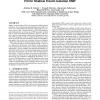Free Online Productivity Tools
i2Speak
i2Symbol
i2OCR
iTex2Img
iWeb2Print
iWeb2Shot
i2Type
iPdf2Split
iPdf2Merge
i2Bopomofo
i2Arabic
i2Style
i2Image
i2PDF
iLatex2Rtf
Sci2ools
ICCAD
2006
IEEE
2006
IEEE
Fill for shallow trench isolation CMP
Shallow trench isolation (STI) is the mainstream CMOS isolation technology. It uses chemical mechanical planarization (CMP) to remove excess of deposited oxide and attain a planar surface for successive process steps. Despite advances in STI CMP technology, pattern dependencies cause large post-CMP topography variation that can result in functional and parametric yield loss. Fill insertion is used to reduce pattern variation and consequently decrease post-CMP topography variation. Traditional fill insertion is rulebased and is used with reverse etchback to attain desired planarization quality. Due to extra costs associated with reverse etchback, “single-step” STI CMP in which fill insertion suffices is desirable. To alleviate the failures caused by imperfect CMP, we focus on two objectives for fill insertion: oxide density variation minimization and nitride density maximization. A linear programming based optimization is used to calculate oxide densities that minimize oxide de...
Calculated Oxide Density | Density Variation Minimization | Hardware | ICCAD 2006 | Oxide Density Variation |
| Added | 16 Mar 2010 |
| Updated | 16 Mar 2010 |
| Type | Conference |
| Year | 2006 |
| Where | ICCAD |
| Authors | Andrew B. Kahng, Puneet Sharma, Alexander Zelikovsky |
Comments (0)

